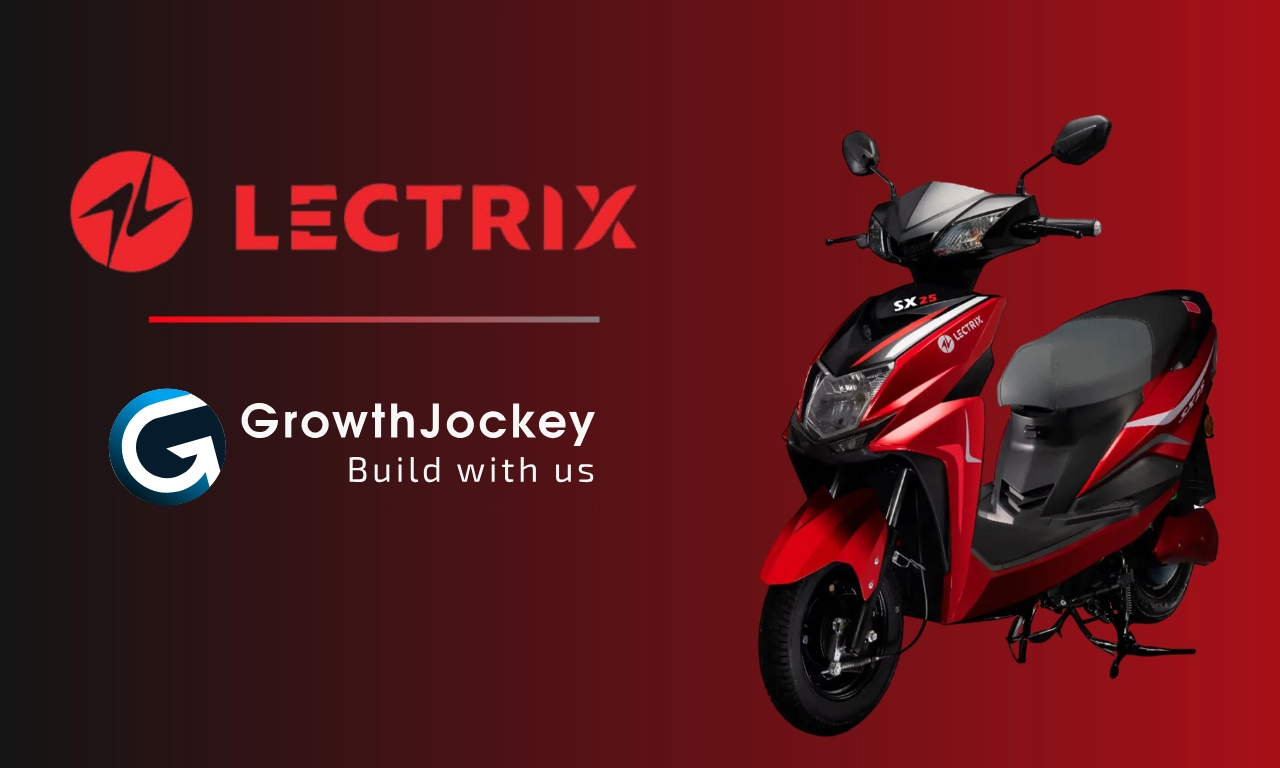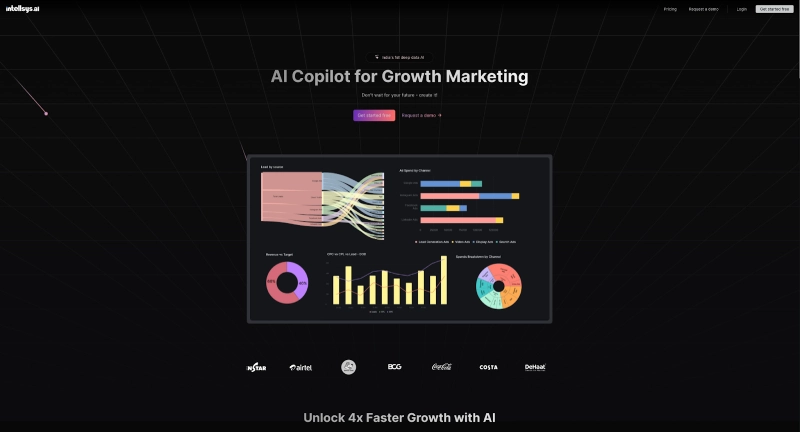Fueling EV Startup Growth in India: The LectrixEV and GrowthJockey Incubation Story

You can feel it on the streets. Electric two-wheelers are everywhere, zipping past fuel stations, weaving through traffic, quietly becoming the new normal. EV adoption in India is clearly rising, and rewiring how people move, spend, and choose.
The numbers say it all: India saw over 856,000 electric two-wheelers sold in 2023 alone.
But momentum on the road doesn’t always mean clarity behind the scenes. EV startup founders are juggling battery technology, broken test ride funnels, and customers who love the idea but hesitate at the buy button.
That’s the space LectrixEV walked into; a solid product, backed by SAR Group, but missing the traction to match. GrowthJockey partnered with them early to fix what mattered: brand confusion, scattered demand, and conversion leaks across the funnel.
This blog breaks down that journey. What got built, what changed, and what other founders can borrow if they're eyeing EV growth in India.
Why EV startup adoption in India is scaling fast
India’s two-wheeler EV space isn’t waiting around. Between policy shifts, rising fuel prices, and better products, the market’s picking up real speed. The signal is loud and clear: this is the moment to build.
Here’s what’s fuelling the EV startup momentum:
-
Lower taxes: GST on EVs cut to 5%, making price points more attractive for buyers.
-
Government push: FAME II targets 10 lakh electric two-wheelers, backed by subsidies and delivery incentives.
-
Rising adoption: FY23 saw 7.3 lakh+ e-2W sales, with Ola Electric alone holding ~33% market share.
-
Penetration projections: India’s e-2W market could hit ~75% penetration by 2030.
-
Global momentum: APAC and Europe are also scaling, with markets projected at $162B and $125B by 2030, respectively.
Founders building now aren’t early, they’re right on time.
How LectrixEV took shape: Incubation as a blueprint
As electric two-wheelers started gaining real traction in India, SAR Group didn’t wait on the sidelines. They saw the shift coming, rising fuel prices, policy pushes, and better batteries and decided to build for it.
That’s how LectrixEV came to life, and we, GrowthJockey, helped shape their go-to-market strategy that works from the ground up.
Let’s take a look at what this brand is about:
A brand born with battery, mobility, and data muscle
LectrixEV had the edge most new EV startups dream of. Backed by SAR Group (the folks behind Livguard, Luminous, Lime.AI, and more), they already had deep expertise in EV battery technology, supply chains, and data systems. That gave Lectrix a serious head start.
A legacy of building, now pointed at green mobility
SAR Group was founded back in 1985 by Rakesh Malhotra and Navneet Kapoor. Over the years, they’ve launched brands that scaled nationally. LectrixEV is their next big leap, this time into electric vehicles in India, designed for sustainability and scale.
It wasn’t growth for the sake of it
LectrixEV wanted to build with a clear purpose: to make green mobility easier to access and grounded in real customer needs. The focus was always on building something that could scale fast, stay affordable, and keep up with how EV policy in India kept changing.
Roadblocks LectrixEV EV runs into
Once LectrixEV entered the direct-to-consumer space, the road wasn’t smooth. EV buyers in India have high expectations and very different needs depending on city, budget, and familiarity.
Before things could scale, we at GrowthJockey had to fix a few e-commerce challenges:
Sales process transformation
The B2C funnel needed more than just leads. It had to support walk-ins, digital interest, test rides, and post-sale ops, all while managing dealers. LectrixEV had to rethink every step to fit how EV adoption in India actually works.
Pricing and payment methods
There’s no fixed playbook yet for how Indians want to buy electric vehicles in India. Whether it’s EMI, bank tie-ups, or instant offers, flexibility was critical. LectrixEV needed to localise pricing and streamline payments without adding friction.
Understanding the consumer market
Not all B2C buyers fit in one box. Urban buyers care about convenience and tech. Smaller towns focus on durability and cost. LectrixEV had to map out these personas to align better with real EV growth in India.
Personalisation and data privacy
Product journeys needed to feel personalised while staying compliant. That meant building data flows that recommended the right ride or service, but still respected privacy. But this did not come easy.
Scaling an EV startup fast means more users, more data, more systems, which makes it way harder to keep things personal and privacy-safe at the same time.
Product or service adaptation
Unlike petrol vehicles, electric two-wheelers are still new for most Indian consumers. People had questions about battery range, charging time, and long-term reliability. Which meant LectrixEV couldn’t afford to wait months for insights.
They needed real-time feedback from test rides, early buyers, and service calls, so they could refine product specs, update manuals, tweak pricing, or even train dealers better.
Customer support and service
LectrixEV was committed to making customer support automation as seamless and helpful as possible. They had to layer in WhatsApp, local service points, and bilingual help to truly deliver. Especially important with first-time EV users looking for trust and guidance.
What GrowthJockey actually built: From ops to visibility
Before we could begin building, there was a clear product game plan to solve these problems. LectrixEV had mapped every part of the puzzle, from who the EV buyer was to how the brand should show up across pricing, sales, after-sales, and charging partnerships.
Now, it was time to put that into motion, through the tech, content, and marketing systems that could actually fuel EV growth in India.
Let’s take a look at how our team at GrowthJockey stepped in and helped that plan come to fruition:
Website execution
In India’s fast-moving electric two-wheeler market, product innovation alone isn’t enough. Startups need website end-to-end systems that turn buyer interest into real bookings, without friction or drop-offs. LectrixEV, with our support and automation tool, Ottopilot, built exactly that.
Here’s what the full-stack, conversion-ready EV business infrastructure looked like in action:
-
Finance integrations: Plugged into 10+ banks and 50+ APIs with eKYC, live underwriting, and mobile-first flows so EV buyers could secure loans in minutes.
-
Decision tools: A petrol vs EV savings calculator and EMI planner helped users visualise monthly outgo and long-term value. Powerful nudges for early adoption.
-
All-in-one account dashboard: Unified test rides, bookings, financing, subscriptions, and support, giving users a smooth, progressive experience across the funnel.
-
Dealer Locator that converts: Integrated Google Maps, product availability, and performance tracking, turning store discovery into high-intent action.
-
Test Ride at Home (TRH): Among India’s first - book an EV in 3 simple steps with real-time slots. A feature designed to remove buyer hesitation.
-
7-Day Subscription Trial: Allowed prospects to experience LectrixEV’s rides without the upfront risk, boosting inventory turns and first-time user trust.
-
Business Admin Suite & CRM: A backend hub to manage contact pipelines, automate sales, run campaigns, and collect real-time customer feedback. This built-in business analytics improved team accountability, resource use, and GTM agility, key for any brand aiming to scale EVs smartly.
-
Payment stack: A smooth checkout powered by RazorPay, fraud controls, and mobile wallets, completing the loop between designing seamless UI/UX and trustworthy payments.
SEO, content, and discoverability
To drive visibility in a crowded market, we led a full-scale SEO overhaul for LectrixEV. We conducted deep keyword research around buyer intent, focusing on terms like EV battery technology, electric vehicles in India, and EV charging station business opportunities in India.
Paired with high-quality, localised content and strong UX improvements, the site delivered faster load times and a smoother user journey. These efforts paid off with a 353% increase in EV prospects, proving how crucial discoverability is to real growth.
Performance marketing
To accelerate adoption, we ran sharply targeted performance marketing campaigns for LectrixEV using our growth marketing tool, Intellsys. The goal was to drive high-intent EV buyers to LectrixEV’s digital doorstep.

Ads were deployed across Google (50–70%), Meta (30–40%), and regional platforms like ShareChat and MX Player, tuned for reach and ROI. Real-time optimisation brought down the cost-per-lead while improving qualified traffic.
Social media marketing
LectrixEV kept it real on social. Instead of pushing ads, we focused on content that actually helped. This entailed videos explaining how EV charging stations in India work, posts comparing EV battery tech, and everyday stories from real riders.
The idea was to make electric vehicles less intimidating and more familiar. Over time, it built credibility and kept the brand top of folks' minds, who were curious about making the switch. For a space like EV growth in India, that kind of trust really moves the needle.
All of this helped the EV startup, LectrixEV, show up where it mattered: on the map, in the search bar, and in the minds of buyers. With us as their growth partner, the brand built the kind of systems that let them scale fast, stay visible, and meet India’s EV demand head-on.
LectrixEV’s growth in motion: Results from a full-stack EV launch
Bringing LectrixEV to life wasn’t about isolated efforts. We built a full-stack EV business, from discoverability to financing to social trust. The real win? It translated into tangible traction.
Here's how each part of the execution helped LectrixEV’s growth:
-
Performance marketing: With our performance marketing stack, LectrixEV reached over 3 million potential users across Google, Meta, and regional platforms. 70% of the leads were OTP-verified, meaning real intent, not just clicks.
-
Social media: By doubling down on helpful, platform-native content, LectrixEV saw a 12.4% spike in reach and a 32.7% rise in impressions. The brand’s growth outpaced industry benchmarks by 2X.
-
SEO & content: A 215% increase in traffic and a 94% lift in leads, driven by high-intent keywords, sharper UX, and fast-loading pages. Domain Authority jumped by 18%, backed by quality backlinks and consistent publishing.
-
Business GTM & infra: In just 3 months, we shipped 85+ webpages and 35+ tech modules, stitched together across CRM, payments, and test ride flows. Site performance improved 330%, creating faster, smoother experiences backed by customer journey analytics for better conversions.
Here's a quick look at the results we brought to LectrixEV across key growth channels:
| Channel | Reach / Traffic | Conversion / Leads | Performance / Authority |
|---|---|---|---|
| Performance marketing | 3M+ Visitors | 70% OTP Verified Leads | - |
| SEO & xontent | 215% Traffic Improvement | 94% Leads Increase | 18% DA Increase, 330% Site Performance |
| Social media & GTM | 12.4% Increase in Reach | 2X Industry Growth | 32.7% Increase in Impressions |
What founders can learn from LectrixEV’s growth playbook
You don’t need a 100-slide strategy deck to build an EV startup that actually scales. What you do need is a clear view of the market, a smart product plan, and systems that don’t break under pressure.
It’s also exactly how LectrixEV, with us in the trenches, went from plan to proof. Here are the strategies to power up your EV business:
-
Size your EV market before placing product bets: LectrixEV used TAM studies to gauge revenue potential, surface EV buyer preferences, and plan a 5-year lineup tailored to real demand, not assumptions. For founders, doing this upfront can help avoid costly misfires and overbuilding in segments with low conversion potential.
-
Pilot your EV battery tech in B2B to refine for B2C: Instead of going straight to consumers, we tested duty cycles, ride comfort, and charging infrastructure through enterprise partners. That meant fewer surprises when scaling to India’s growing EV adoption curve, and more confidence in our product-market fit framework. You can do the same to validate performance before pouring money into mass visibility.
-
Build your digital EV stack as early as your product: LectrixEV launched with a solid tech foundation, such as a site on Remix/TS, dealer discovery tools, EMI calculators, and even a Test Ride at Home flow. All of it made EV research, pricing comparisons, and booking feel native. Founders should treat this as critical infra, not a “post-launch” nice-to-have.
-
Use layered growth, not a one-trick funnel: SEO blogs on EV battery technology, Google Maps integrations for charging stations, Meta ads for verified leads, and creator-led reels, all worked together. Founders chasing EV growth in India can’t afford to rely on a single channel. Compound traffic by stacking discoverability across search, social, and O2O plays.
If you're building for India’s EV future, this isn’t just strategy on paper. It's a playbook that’s been built, tested, and scaled in the real world. Take what fits, tweak what doesn’t, and build systems that grow with you.
Lessons from the LectrixEV journey for EV startups in India
LectrixEV’s EV startup journey proves that when you pair the right product with the right systems, momentum follows. From pricing and discovery to EV charging infrastructure and loan approvals, every touchpoint was built to support India’s fast-growing appetite for two-wheeler electrics.
GrowthJockey helped lay the foundation with SEO content that ranked for high-intent EV battery technology terms. They also launched performance campaigns that brought in verified leads and built tools to simplify every step of the buying journey.
EV adoption in India is evolving fast, and startups can’t afford to rely on product alone. Growth needs infrastructure, visibility, and trust. That’s what made LectrixEV stand out.
For early-stage founders in the EV space, the right partner can mean the difference between a promising launch and long-term traction. GrowthJockey acts as a full-stack incubator, co-building ventures with scalable tech, clear GTM playbooks, and growth systems that hold up in the real world.
It's not consulting. It's building, with skin in the game.
FAQ’s on EV startup in India
Will EV get cheaper in 2025?
Lower battery costs and economies of scale are expected to make electric vehicles in India more affordable in 2025. Policy support like FAME II (and its successor schemes) continues to cut price gaps. Expect more brands entering the market and pricing becoming more transparent and competitive.
What is the EV adoption rate in India?
As of late 2023, EVs accounted for around 5% of total vehicle sales in India: a mix of two- and three-wheeler traction. According to a Bain & Company report, this adoption could grow toward 40% by 2030 driven by better EV charging infrastructure and financing access.
Which Indian state is leading in EV adoption?
Uttar Pradesh leads on EV adoption, contributing over 14% of total EV sales in India in 2023 and dominating the electric three-wheeler segment with over 40% share. The state’s EV manufacturing and public charging push has made it a standout.
How many EV owners are there in India?
In 2023, India sold 856,000 electric two-wheelers and over 580,000 electric three-wheelers. Marking it as a clear sign of rising EV adoption in India across both personal and commercial segments.








